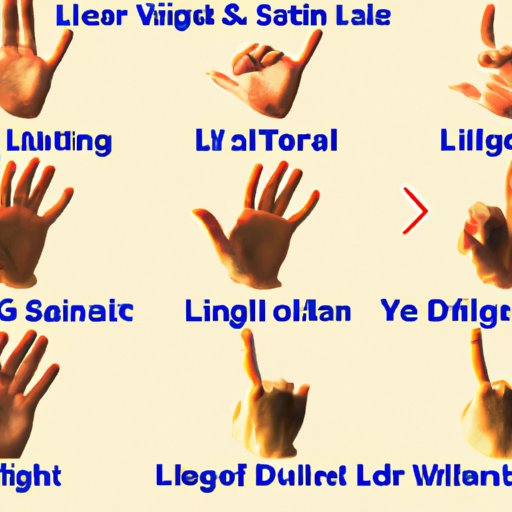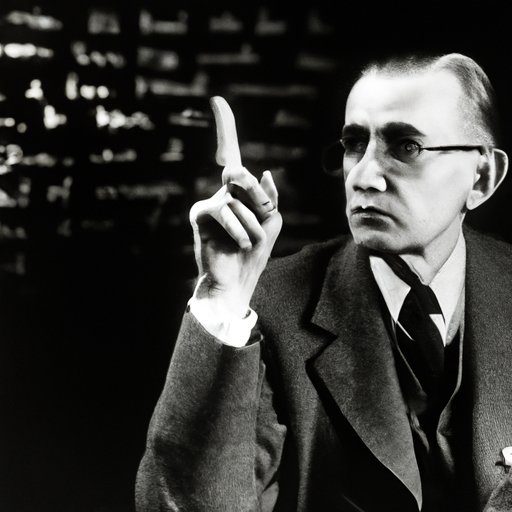Introduction
Sign language is an important form of communication used by people all over the world. It is a visual-manual language that uses hand gestures, facial expressions and body language to convey meaning. Sign language is used primarily by those who are deaf or hard of hearing, but it can also be used by anyone who wants to learn it. But who invented sign language? This article will explore the history of sign language, who invented it and its impact on deaf culture, as well as the different types of sign language, the benefits of learning it, and the psychology behind it.
Biography of the Inventor of Sign Language
The origins of sign language are not clear, but one of the main figures credited with inventing sign language is Abbé Charles-Michel de l’Épée. He was born in France in 1712 and was a priest, educator, and philanthropist. He was devoted to helping deaf people and was the first person to recognize sign language as a legitimate form of communication. He founded the first school for the deaf in Paris in 1760 which used sign language as a primary form of teaching and communication. De l’Épée believed that sign language was a natural language and should be respected; he wrote the first dictionary of signs and published several books on the topic. His work helped to legitimize sign language, and his influence can still be seen today in modern sign languages such as American Sign Language (ASL).
History of Sign Language: How it Came About
Sign language has been in use since ancient times, but it wasn’t until the 18th century that it began to be recognized as a legitimate language. The development of sign language is closely linked to the history of deaf education. Before the 18th century, people who were deaf were often isolated and stigmatized, and there were no effective ways to teach them to communicate. In the 1700s, a number of schools for the deaf were established in Europe, and these schools used a variety of methods to teach their students, including sign language. The recognition of sign language as a legitimate language was a significant moment in history, as it allowed deaf people to communicate more effectively and to be accepted into society.

The Impact of Sign Language on Deaf Culture
The emergence of sign language had a profound impact on deaf culture. It enabled deaf people to communicate more effectively and to gain access to new opportunities. Sign language allowed deaf people to form their own communities, where they could share experiences and build relationships. Sign language also gave deaf people a sense of identity and pride, as they could now express themselves in a language that was unique to them. Today, sign language is an integral part of deaf culture, and it is used in many aspects of life, from education to entertainment.

A Look at Different Types of Sign Language
There are many different types of sign language, and each type has its own unique characteristics. For example, American Sign Language (ASL) is the most widely used sign language in the United States. It is a visual-manual language that uses hand shapes, facial expressions, and body language to communicate. ASL is related to French Sign Language (LSF), which was developed in France in the 18th century. Other sign languages include British Sign Language (BSL), Australian Sign Language (Auslan), and International Sign Language (ISL). Each type of sign language has its own grammar and vocabulary, and some are mutually intelligible, meaning that people who speak one type can understand another type.

The Benefits of Learning Sign Language
Learning sign language can have many benefits, both for individuals and for society as a whole. It can help to improve communication between deaf and hearing people, as well as increase awareness and understanding of deaf culture. Learning sign language can also help to reduce barriers to communication, as it allows people to communicate without relying on spoken language. Additionally, research has found that learning sign language can help to improve cognitive skills, such as memory, problem-solving, and concentration. Finally, learning sign language can also help to foster empathy and respect for those who are deaf or hard of hearing.
Understanding the Psychology Behind Sign Language
Research has shown that sign language can have a positive effect on the brain. Studies have found that signing activates different parts of the brain than speaking does, and that it can help to improve cognitive functioning. Signing is also believed to help improve social skills, as it requires face-to-face interaction and encourages nonverbal communication. Additionally, signing has been found to be beneficial for emotional regulation, as it can help to reduce stress and anxiety. Finally, signing can also help to improve language acquisition, as it can provide a “bridge” between spoken language and written language.
Conclusion
Sign language is an important form of communication that has been used for centuries by millions around the world. It was invented by Abbé Charles-Michel de l’Épée in the 18th century, and its emergence helped to legitimize sign language and give deaf people a way to communicate. The development of sign language has had a profound impact on deaf culture and has enabled deaf people to form their own communities and gain access to new opportunities. There are many different types of sign language, each with its own unique characteristics, and learning sign language can have many benefits, both for individuals and for society as a whole. Finally, research has shown that sign language can have a positive effect on the human brain, and can help to improve cognitive functioning, social skills, and language acquisition.

Final Thoughts on the Inventor of Sign Language
Abbé Charles-Michel de l’Épée was a revolutionary figure in the field of deaf education, and his work helped to legitimize sign language and give deaf people a way to communicate. His legacy continues to live on today, and his influence can be seen in the many different types of sign language that are used around the world. Understanding the history of sign language and who invented it is an important part of appreciating the power of this language and the impact it has had on deaf culture.
(Note: Is this article not meeting your expectations? Do you have knowledge or insights to share? Unlock new opportunities and expand your reach by joining our authors team. Click Registration to join us and share your expertise with our readers.)
